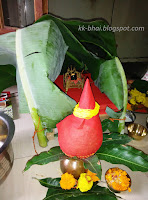36. Gomati Chakra - गोमती चक्र!
37. Panchamrita - पञ्चामृत
38. पान के पत्ते - Betel Leaves
39. Puja Aasana /mat - पूजा आसन
40. तिल (Til) - Sesame seeds
Blogs about known and less known flowers of worship and other things used in worship (pujan) of Hindu Religion.
 |
| Banana Plants, with a whole bunch of fruits and hanging flower केले के पेड़, फलों का घौंद और लटकता केला फूल |
The banana plant has a special significance in Hindu mythology and tradition. It is believed that "Vrihaspati Devta", a form of God Vishnu resides in the banana plant. Religious folks in India follow many "Vrats" related to days of the week. For example, Sun God is worshipped with some rules on Sundays, Shiva on Monday, Hanumaan on Tuesday, and Ganesha on Wednesday. Similarly, some of them follow a "Vrat" named "Vrihaspatiwar Vrat" or "Guruwar Vrat". In this "Vrat" "Vrihaspati Deva" is worshipped with certain rules on each Thursday. This Puja needs many things that are yellow in color because yellow color is liked by God Vishnu and his different forms. They need yellow flowers, Chana Dal (Bengal gram pulse), Munakka (a type of raisin), yellow rice, yellow sweetmeat (Besan Laddu), and turmeric (Haldi) for the worship of "Vrihaspati Devta". The worship is done near a Banana plant. Turmeric water is poured over the banana plant and gram pulse, Munakka, Besan laddu, and ripe yellow banana fruit is put near the root of the banana plant. Arti with Deepak is done. The devotee does not take salt, onions, garlic, or non-veg the whole day till the next morning. They wear yellow clothes and eat yellow eatables in their only meal during the "Vrat". After the worship, they hear a "Katha" (Story) of "Vrihaspati Deva" in which it is stated that the follower of this "Vrat" gets wealth, peace, and desired things.
 |
| Worshipping a Banana plant |
The banana leaves, fruits, and the plant is thought to be auspicious in Hindu traditions. On the occasion of Lakshmi worship on Diwali (Deepawali) this plant is put at both sides of the gates of the house or shop. Goddess Lakshmi is the wife of Vishnu. Even on the occasion of Satyanarayan Puja which is mostly performed at home, the four legs of the Aasan are tied with banana leaves and all the four leaves are tied together at the top. Even Prasad may be distributed in small pieces of banana leaves. On auspicious occasions like marriage and Yajnopaveet (Janeu), banana plants are used for making Torandwar and Mandapa.
 |
| Banana leaves around the Aasana of Satyanarayana Bhagwaan |
Not only this, during worship if metal plates are not available the Bhog to gods may be offered on banana leave pieces just like betel leaves. During Navratri, Bhog of Kheer to Goddess Durga is offered on banana leaves. In Sanskrit, banana fruit is called "Kadali Fal" and in Hindi -"Kele ka Fal". Ripe and yellow banana fruits are one of the fruits which a devotee prefers to offer to gods. Though many varieties of banana are available in the market a devotee's first choice is the local smaller variety generally called "Chiniya Kela". When unavailable, only then they use other varieties like -Singapuri, Robusta, or Cavendish. In the Chhath Puja, a full bunch of banana (Kele ka Ghoud) is necessary and only local variety is permitted which is available in that season.
 |
| Desi whole banana bunch in Chhath Puja छठ महापर्व में देसी केले का घौंद |
The banana leaves are also used by vegetarian people as a plate for consuming meals in India. It is mostly in the Sothern part of India where banana plants are abundantly grown. By tradition and devotional respect to this plant, they refrain from putting non-vegetarian items on this leaf-plate.
The banana plant has been used in old paintings and sculptures as it has been a part of Indian culture for a long time. It brings good luck and wealth to our homes.
 |
| Banana Plants as Torandwaar |
 |
| Hawan-Samagri |
 |
| Humaad |
 |
| Parthiv Shivlinga (Image source Google) |
 |
| Poogiphal, Supari Betelnut or Arecanut |
 |
| The Supari (Betel nut) worshipped as Ganesha (wrapped in Mouli thread, a Yagyopaveet around it and kept in a "Katori" over dry Akshat |
 |
| Puja Supari, Poogiphal |
 |
| Sarauta, The Nutcracker |
 |
| Different sweetmeat of sesame seeds (Til) for Makar Sankranti |
 |
| White and Black sesame seeds |
 |
| Puja Asana/Puja Aasani/Puja Mat |
अयि विभो शरणागतवत्सल यदपि हीनमिदं भवतां कृते।
तदपि भक्तजनं खलु वीक्ष्य मां समुचितं प्रियमासनमास्यताम྄।(Ayi Vibho Sharanagatvatsala Yadapi Heenmidam Bhawatam Krite